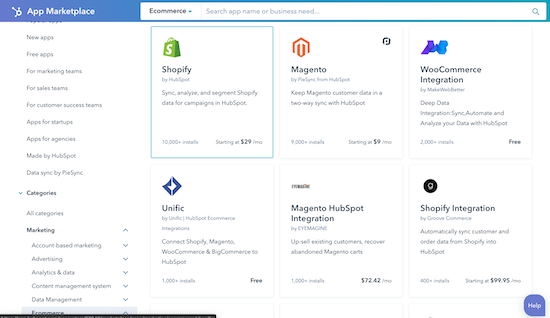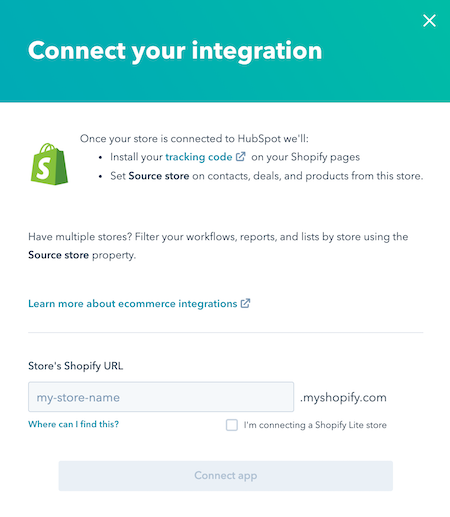Owning and operating a business has never been easier from an operational standpoint. With so many business-enabling platforms and software available today, you could sell your products or services out of your car trunk with ease.
Two of the top platforms that can help support your business efforts are HubSpot and Shopify. Both have revolutionized how businesses operate, especially online.
So what happens when you marry the two together?
What Is Shopify?
If you're subscribed to us, you know that we're big fans of HubSpot. But what's Shopify?
Shopify is an eCommerce platform that allows users to create an online store to sell their products. One of the leading commerce platforms on the market today, it's designed to meet the needs of businesses of all sizes.
Users and customers can host transactions online, over social media, in-store, or simply out of a booth over the platform.
And when you pair it with HubSpot, you'll be able to engage your customers on an entirely different level.
4 Benefits of the HubSpot-Shopify Integration
If you’re currently using both Shopify and HubSpot, your time is now. The Shopify integration feature is free for all HubSpot users who are also already paying for their Shopify platform, and there’s every reason to be taking advantage of this.
1. Abandoned Cart Recovery
Using the two platforms together can help lessen cart abandonment and recover a lot of the revenue that would have been lost because of it.
By leveraging different workflows and email marketing techniques, you can reengage customers and enable them to finish their purchase with the click of a button.
2. Boost Brand Loyalty
You'll be able to nurture customer relationships on an entirely different level with this integration of personalized and automatic messaging.
By leveraging the right email marketing strategies, you can:
- Welcome and onboard new visitors
- Follow up with existing customers
- Promote deals and new offers
- Encourage repeat purchasing
All of these different tactics can come together to increase your customers' loyalty to your business (with the assumption you're consistently delivering value).
Not only does this boost revenue, but you'll also increase the lifetime value of your customers.
3. Access to HubSpot's Tools
Your online store will grow by leaps and bounds once you start utilizing HubSpot's wide deck of tools. With visitor tracking, lead intelligence, and valuable analytics monitoring everything, you'll be able to keep tabs on every opportunity that comes your way.
Prioritizing your customers becomes a cinch, and implementing strategies to win them over no longer takes long, complex processes before you can green-light them.
4. No Additional Cost
Not to harp on this fact, but it truly is a great perk.
Both HubSpot and Shopify require investments, so it's nice to know that you can integrate the two without an extra charge.
You can choose the plans that work best for your business and your budget, and then connect your Shopify store to your HubSpot account in a matter of minutes.
How to Integrate Your HubSpot Account With Shopify in 5 Steps
On the topic of connecting the two, let's go over just how easy it is to integrate your accounts on HubSpot.
1. Go to HubSpot's App Marketplace.

You'll want to filter their endless list of apps and integrations by either searching for "Shopify" or heading to the eCommerce section of the marketing apps.
2. Connect Your Store.
Click the "Connect app" button, enter your store's Shopify URL, and click "Connect to Shopify" to connect your HubSpot and Spotify accounts.

3. Log Into Shopify
A pop-up window will appear asking for your Shopify credentials. To complete the connection, you'll need to enter your credentials and click "Log in."
Your Shopify account will start connecting to your HubSpot portal.
4. Add Additional Stores.
If you have any other Shopify stores, you can connect them as well. Simply wait until your first store is connected and head to the Shopify integration page.
Click the dropdown menu in the upper right corner and select "+ Connect another store."
Enter the store's Shopify URL and begin the process again.
5. Sync Your Data.
To set up data sync, you'll need to go to the HubSpot App Marketplace again and click the "Manage apps" button on the upper right hand side.

Find your Shopify integration and select between these two options:
- One-way sync: Enabled by default, data will sync from Shopify to HubSpot only.
- Two-way sync: This option will ensure that your customer contact properties are up to date by exchanging data between both platforms.
And there you have it! Your HubSpot account is fully integrated with your Shopify store.
How to Edit Field Mappings between Shopify and HubSpot
Step 1: Go to Settings
Click the gear icon in your top HubSpot nav menu.
Step 2: Go to Connected Apps
This can be found under the "Integrations" dropdown under the "Account Setup" header in the left nav bar of your settings.
Step 3: Click on Shopify
Type "Shopify" into the connected app search bar and click on the button for Shopify.
Step 4: Click on the Appropriate Object Type Tab
Click on contacts, deals, or products to see information about the object type you wish to edit the mappings for.
Step 5: Click on [Object] Field Mappings
This will open the view for mappings between HubSpot properties and fields in Shopify.
Step 6: Click on Add New Mapping
This will open up the menu to add a new field mapping.
Step 7: Create Your Mapping
Using the dropdown menus, choose the HubSpot property and Shopify fields you wish to map.
Step 8: Click Save to Finish
When finished, click "Save" to create your mapping.
To Edit an Existing Field Mapping:
Go to the map you wish to edit and click on the "Actions" button, then click "Edit" from the dropdown.
To Delete a Field Mapping
Click on the "Actions" button and then click "Delete" from the dropdown.
How to Use Your HubSpot-Shopify Integration
Once everything's connected, you'll have a ton of fun exploring all the different ways that you can use this integration to your advantage.
Here's a list of all the great features that come from this union:
Customers From Shopify Become Contacts in HubSpot.
Whenever new data or updated information in Shopify is available, it will also be reflected in HubSpot. This provides a single contact record for marketing, sales, products, and order information.
Once all that data is in one place, you can then begin connecting with customers that you may not have reached before. Just like the contacts you already had in HubSpot, you’ll be able to more clearly segment and target these customers.
Not only will new campaign possibilities help increase revenue, but they’ll also increase customer lifetime value.
Orders from Shopify Become “Deals” in HubSpot.
This is where HubSpot’s "deals" feature comes into play.
You’ll be able to easily track deals and orders in HubSpot with visibility into which contact and product the deal is associated with, as well as what stage the deal is in.
Using this information, you can set up lists and workflows to begin automating the marketing processes for your online store. For example, you can set up lists, certain criteria, and create automated messages that remind your customers when it’s time to reorder certain products.
To make the automation process even easier, the Shopify integration comes with three workflows that have already been created for you: abandoned cart nurturing, new customer welcome, and re-engagement.
Shopify Products Are Added to the HubSpot Product Library.
This allows you to better track your products and analyze what your customers are buying.
Gaining insight into critical data, like purchase patterns, will also allow you to more strategically create lists and segments based on order information.
The eCommerce Dashboard Is Added to Your Dashboards.
All the analytics for your newly integrated feature will be available as an eCommerce dashboard. When automatically added to your dashboard, the default reports you’ll see include:
- Order snapshot
- New sales processed summary
- Average order value by source
- Lifetime order value by source
- Net new customers vs. last month
- Sales processed this month vs. goal
- Abandoned cart recovery
Measuring and tracking all of your store's data will never be easier. You'll be able to identify gaps and areas for improvement, optimizing your business for success.
There's nothing wrong with getting the best of both words. Both platforms can enable your business in amazing ways, but using them together takes you one step further.
Integrating HubSpot and Shopify couldn't be easier, so jump to it!


Douglas Phillips
Former military brat, graduated from Leilehua High School in Wahiawa, Hawaii in 2001. After earning my Bachelor's in English/Professional Writing, took on a job as a writer here at Bluleadz.